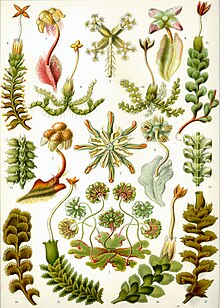
Back Lewermos Afrikaans نباتات كبدية Arabic نباتات كبديه ARZ Hepaticophyta AST Ciyərotu Azerbaijani Пячоначныя імхі Byelorussian Чернодробни мъхове Bulgarian Lumut hati BJN Hepàtiques Catalan Marchantiophyta CEB
| Liverworts | |
|---|---|

| |
| "Hepaticae" from Ernst Haeckel's Kunstformen der Natur, 1904 | |
| Scientific classification | |
| Kingdom: | Plantae |
| Clade: | Embryophytes |
| Clade: | Setaphyta |
| Division: | Marchantiophyta Stotler & Stotl.-Crand., 1977[2] emend. 2000[3] |
| Classes and orders | |
The Marchantiophyta (⫽mɑːrˌkæntiˈɒfətə, -oʊˈfaɪtə⫽ ) are a division of non-vascular land plants commonly referred to as hepatics or liverworts. Like mosses and hornworts, they have a gametophyte-dominant life cycle, in which cells of the plant carry only a single set of genetic information.
It is estimated that there are about 9000 species of liverworts.[4] Some of the more familiar species grow as a flattened leafless thallus, but most species are leafy with a form very much like a flattened moss. Leafy species can be distinguished from the apparently similar mosses on the basis of a number of features, including their single-celled rhizoids. Leafy liverworts also differ from most (but not all) mosses in that their leaves never have a costa (present in many mosses) and may bear marginal cilia (very rare in mosses). Other differences are not universal for all mosses and liverworts, but the occurrence of leaves arranged in three ranks, the presence of deep lobes or segmented leaves, or a lack of clearly differentiated stem and leaves all point to the plant being a liverwort. Liverworts are distinguished from mosses in having unique complex oil bodies of high refractive index.
Liverworts are typically small, usually from 2–20 mm (0.079–0.787 in) wide with individual plants less than 10 cm (3.9 in) long, and are therefore often overlooked. However, certain species may cover large patches of ground, rocks, trees or any other reasonably firm substrate on which they occur. They are distributed globally in almost every available habitat, most often in humid locations although there are desert and Arctic species as well. Some species can be a nuisance in shady greenhouses or a weed in gardens.[5]
- ^ Cite error: The named reference
Walker 2010was invoked but never defined (see the help page). - ^ Stotler, Raymond E.; Barbara J. Candall-Stotler (1977). "A checklist of the liverworts and hornworts of North America". The Bryologist. 80 (3). American Bryological and Lichenological Society: 405–428. doi:10.2307/3242017. JSTOR 3242017.
- ^ Crandall-Stotler, Barbara; Stotler, Raymond E. (2000). "Morphology and classification of the Marchantiophyta". In A. Jonathan Shaw; Bernard Goffinet (eds.). Bryophyte Biology. Cambridge: Cambridge University Press. p. 21. ISBN 0-521-66097-1.
- ^ Liverworts Homepage | UNB
- ^ Schuster, Rudolf M. (1992). The Hepaticae and Anthocerotae of North America. Vol. VI. Chicago: Field Museum of Natural History. p. 19. ISBN 0-914868-21-7.
© MMXXIII Rich X Search. We shall prevail. All rights reserved. Rich X Search